 |
Slide frames and Slide framing machines
Even if the digital photography is displacing more and more the well tried analog photography, each year, still millions of slides are exposed and framed. Many a photographer does not plan the switch from analog to digital for the next ten years and many of them even do not plan it at all in this live. Due to this reason, the framing of slides is still in and is practiced innumerably.
Wide range of magazines, slide frames and slide framing machines in our Online-ShopIn this website, we treat CS Slide Frames in detail, the associated CS magazines and the framing of the slides with slide framing machines. We will also go into the advanced CS2 slide frames and the referreing slide framing machine in detail.
Reflecta CS slide frame and CS slide magazine
Despite of the continuously increasing sales of digital cameras and the resulting decrease of the sales in the classic analog field of the photography, there are still confirmed fans who are convinced of the "good old" film. Thus, in the year 2004, still 120 millions of slide films were sold. In the past decades, countless slide frames and slide magazines have been developed for the framing and storage of the slides, but despite of the variety, still one problem remains which is the spillage of the slides in case a slide magazine is knocked over or dropped by carelessness. How often it has happened that before a lecture in which slides are applied, all slides of a magazine were spread all over the floor and the lecturer could, damped with sweat, barely recollect the slides and put them back in the right order? Furthermore, some slides are really thick with up to 3,2 millimetres and need therefore lots of space for their archival storage.
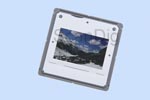
In order to face exactly this problem, the firm AGFA developed in the year 1977 a novel and patent-registered CS slide frame. In the year 1984, the production was taken over by the firm Reflecta, and in the year 1997, after the patent had expired, other firms of the photography sector also began to produce CS frames. But which are really the advantages of the original item of Reflecta?
The plastic frame with a size of 5x5 centimetres and 1,8 millimetres thickness consists on two pieces, a dark-grey basis and a white cover that is foldable forward and fixed alongside the longitudinal side of 36 millimetres. At the side of the fixation, the basis and the cover form together a kind of bag, in which the slide can be comfortably pushed in by holding it from the perforated side. In order to avoid leaving fingerprints on the slide during this handling, it is recommendable to use some tweezers. Of course, the picture has to be previously well cut off from the film strip with some scissors, better by using some cotton gloves.
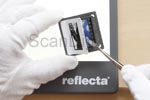 The slide is now located in one side of the bag and the others are held and fixed by a marginal frame that is built into the basis and four additional knobs. Thus, if a slide is properly cut, it has barely a margin of 1 millimetre for moving so that the slide is well snugged into the frame.
The slide is now located in one side of the bag and the others are held and fixed by a marginal frame that is built into the basis and four additional knobs. Thus, if a slide is properly cut, it has barely a margin of 1 millimetre for moving so that the slide is well snugged into the frame.
Thereafter, the cover has to be lowered and the two upper corners pressed tightly against each other with the thumb and the index finger until a clear "click" is hearable. In order to ultimately guarantee the best possible flatness of the slide, the three sides that have additional knobs in the center are to be pressed together. Although now the slide is really fixed in the frame, it is very easy to get it out. Therefore, the cover has a clearly visible grooving with which it can be openend by putting a fingernail or a peakish object and pulling, without damaging the frame. Thus, the slide frame can be reused.
Many have probably already wondered why the frame is bicoloured? On the one hand, of course, in order to distinguish the front and the back part, but on the other hand, the white surface offers a protection against the heat caused by the lamp of the slide projector. The white colour reflects the heat caused by the lamp and thus avoids an overheating of the frame and a probable damage of the film. Also the labeling of the frame is possible on the white side. Until now, everything is fine, but what is really the chief attraction of the CS system?
At all edges of the front and the back part, the CS frame has a narrow bar
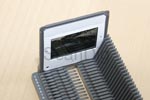 that forms a kind of guide rail and additionally, in the centre of all four outer sides there is a little groove. Now, the CS slide magazine that was specially developed for this kind of frames, comes into play. In each insertion of a slide, this magazine has a tiny, slightly flexible plastic part at the bottom with a knob. If the slide is pushed at one side, alongside the guide rail into the magazine, the placstic part has to be pushed a little down and the knob engages into the groove of the slide. Now the slide is firmly inside the magazine, even if it is dropped or thrown to the ground. Now, one might wonder how to get the slide out? Therefore, it is enough to push it gently into direction to the pullout, and it slides smoothly out of the magazine due to the little part of silicon in the polystyrene(plastic).
that forms a kind of guide rail and additionally, in the centre of all four outer sides there is a little groove. Now, the CS slide magazine that was specially developed for this kind of frames, comes into play. In each insertion of a slide, this magazine has a tiny, slightly flexible plastic part at the bottom with a knob. If the slide is pushed at one side, alongside the guide rail into the magazine, the placstic part has to be pushed a little down and the knob engages into the groove of the slide. Now the slide is firmly inside the magazine, even if it is dropped or thrown to the ground. Now, one might wonder how to get the slide out? Therefore, it is enough to push it gently into direction to the pullout, and it slides smoothly out of the magazine due to the little part of silicon in the polystyrene(plastic).
Beside the safety of spillage, the CS frames are also space-saving. A magazine has a capacity of 100 slides, this means 200 pieces per slide box, thus a space saving of up to 50% compared to the standard slide magazines.
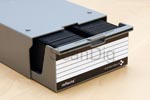 Both of the magazines are put in one draw that is then inserted into the box and a locking device avoids unintentional moving to the exterior. Several slide boxes can be simply piled on each other, as there are four knobs on the upper side of each box that fit exactly into the notches at the button of the other box and thus the moving is prevented. A special feature of the original magazines of Reflecta are the specially visible labelings and a big adhesive label for the labeling of the box. By the way, the CS frames are also appropriate for the digitalization by means of batch scanners as the Reflecta DigitDia 6000 and the Nikon Coolscan 5000 with Slidefeeder SF-210. With this, it is possible to scan up to 100 slides without having to "refeed" the scanner again, and also the transport runs so smoothly as with no other frame.
Both of the magazines are put in one draw that is then inserted into the box and a locking device avoids unintentional moving to the exterior. Several slide boxes can be simply piled on each other, as there are four knobs on the upper side of each box that fit exactly into the notches at the button of the other box and thus the moving is prevented. A special feature of the original magazines of Reflecta are the specially visible labelings and a big adhesive label for the labeling of the box. By the way, the CS frames are also appropriate for the digitalization by means of batch scanners as the Reflecta DigitDia 6000 and the Nikon Coolscan 5000 with Slidefeeder SF-210. With this, it is possible to scan up to 100 slides without having to "refeed" the scanner again, and also the transport runs so smoothly as with no other frame.
Manual and automatic framing of CS slides
As already described in the previous paragraph, the manual framing of the slides is the most simple but also the most uncomfortable and time spending method of framing slides. In order to frame a slide film of 36 pictures of 35 mm with this method, nearly a quarter of hour is needed. Thereby, one has to be very concentrated, as by cutting the film strip it can easily happen that by mistake, it is cut into the picture with the scissors. The separating web between each picture is very narrow and therefore it requires an exact operation. Here, a light box is very useful, as the film strip is well x-rayed and the separating webs are well recognizable in order to cut each picture and put it afterwards with the help of the tweezers into the frame. For the occasional framing of slide films, this is the most simple method; but how are we looking if there is a big amount of slides to frame? Is it needed to sit for hours or even during whole evenings highly concentrated in front of the light box? The answer is: no! Because for this, Reflecta has developed the CS Servicemaster.
With this device, it is possible to frame comfortably and particularly fast CS slide frames. If for the manual method a quarter of hour per film is needed, the working time with the CS-Servicemaster is reduced to approximately 9 minutes. If this calculation is applied to the working time of many films, soon a time saving of several hours results.
 But how does the automatic framing with the CS-Servicemaster work? After unpacking the device, one gets a dark grey and rectangular plastic box approximately sized 15x9x5 centimetres and a further plastic item with an integrated amplifier. Furthermore, on the plastic box there is on the left side a white surface that is similar to a light box, a red pusher and a red arm, and at the right an aperture is visible and one is uncertain how to frame slides with it. The best is to follow the manual first! One is then asked to unscrew the bottom of the CS-Servicemaster and put two batteries in that serve as a power source for the lamp that lightens the mini light box. The lamp can be switched on and off by a switch that is located at the left side. The attached amplifier is to be fixed above the "light box" with the purpose of positioning the film stripe in a better and more exactly way.
But how does the automatic framing with the CS-Servicemaster work? After unpacking the device, one gets a dark grey and rectangular plastic box approximately sized 15x9x5 centimetres and a further plastic item with an integrated amplifier. Furthermore, on the plastic box there is on the left side a white surface that is similar to a light box, a red pusher and a red arm, and at the right an aperture is visible and one is uncertain how to frame slides with it. The best is to follow the manual first! One is then asked to unscrew the bottom of the CS-Servicemaster and put two batteries in that serve as a power source for the lamp that lightens the mini light box. The lamp can be switched on and off by a switch that is located at the left side. The attached amplifier is to be fixed above the "light box" with the purpose of positioning the film stripe in a better and more exactly way.
The film strip is to be pushed from the left side into a guide rail and transported with the help of the pusher until it nudges to the right.
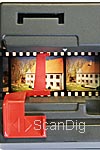 Upside the lamp there is a marking arrow that now points exactly to the center of the second separation web (viewed from the right). The picture to be cut is now properly positioned and by pushing down the arm, it is cut from the rest of the film stripe. Now, one takes the CS frame, opens the white cover at an angle of approx. 45° and pushes it into the aperture at the right side. Thereby, it has to be paid attention that the grey part of the frame is located on the springy binders that are located at the aperture, but at the same time, under the fixed holders located behind. With a little expenditure of energy the frame is to be pushed into the aperture as far as it will go.
Upside the lamp there is a marking arrow that now points exactly to the center of the second separation web (viewed from the right). The picture to be cut is now properly positioned and by pushing down the arm, it is cut from the rest of the film stripe. Now, one takes the CS frame, opens the white cover at an angle of approx. 45° and pushes it into the aperture at the right side. Thereby, it has to be paid attention that the grey part of the frame is located on the springy binders that are located at the aperture, but at the same time, under the fixed holders located behind. With a little expenditure of energy the frame is to be pushed into the aperture as far as it will go.
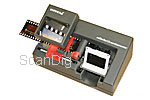 In this conection, the slide is pushed simultaneously into the bag of the frame. Unfortunately, this was not always the case during the tests I have made, so that the readjustment of the slide was neccessary for a couple of times. Also, the exact positioning of the stripe with the help of the amplifier resulted to be rather imprecise so that I prefered to abstain from it. Afterwards the frame is pulled again out of the aperture and with a loud "clack", the white cover is pushed against the grey base part and the frame is tightly locked. In order to frame more slides, the procedure is simply repeated accordingly.
In this conection, the slide is pushed simultaneously into the bag of the frame. Unfortunately, this was not always the case during the tests I have made, so that the readjustment of the slide was neccessary for a couple of times. Also, the exact positioning of the stripe with the help of the amplifier resulted to be rather imprecise so that I prefered to abstain from it. Afterwards the frame is pulled again out of the aperture and with a loud "clack", the white cover is pushed against the grey base part and the frame is tightly locked. In order to frame more slides, the procedure is simply repeated accordingly.
I recommend everybody who wants to frame his slides with the CS-Servicemaster to try the operating steps with a test stripe when using the device for the first time in order to get familiar with the device. In general, with the Reflecta CS-Servicemaster one gets a comfortable framing device, but for its use some practice is required and every picture will not fit immediately exactly in the frame, a thing that again affects negatively the aimed time saving. Thus, the CS frame is the ideal slide frame for the manual framing, but for a smooth machine framing with the CS-Servicemaster I can only recommend this conditionally.
Reflecta CS2 frame and its framing
It is pleasant that Reflecta advanced the CS frame and introduced the CS2 slide frame in the year 1996 into the market, in order to continue simplifying the automatic framing. This affects the devices for the manual framing and also the framing of film slides in the laboratories.
 Basically, this frame is equally built as the CS frame, but only the white cover is turned by 90°, so that now, on the 24 millimetres side of the crop, the cover and the basis form together the bag and now the basis is black in order to distinguish it from the normal CS frames. Due to the changed opening direction, the CS frame is only conditionally appropriate for the manual framing, but therefore it is so much the better for the automatic framing with the appendant framing device
CS2-Servicemaster. This device has approximately the same size as the CS-Servicemaster, and also the film stripe is pushed from the left side through a kind of guard rail whereupon the stripe is also located on a tiny surface that is x-rayed. Thus, here, the exact positioning of the stripe is also possible to appraise with the help of two marking arrows. Contrary to the CS-Servicemaster, here, the pluggable amplifier facilitates the central alignment of the second separation web at the marking arrows.
Basically, this frame is equally built as the CS frame, but only the white cover is turned by 90°, so that now, on the 24 millimetres side of the crop, the cover and the basis form together the bag and now the basis is black in order to distinguish it from the normal CS frames. Due to the changed opening direction, the CS frame is only conditionally appropriate for the manual framing, but therefore it is so much the better for the automatic framing with the appendant framing device
CS2-Servicemaster. This device has approximately the same size as the CS-Servicemaster, and also the film stripe is pushed from the left side through a kind of guard rail whereupon the stripe is also located on a tiny surface that is x-rayed. Thus, here, the exact positioning of the stripe is also possible to appraise with the help of two marking arrows. Contrary to the CS-Servicemaster, here, the pluggable amplifier facilitates the central alignment of the second separation web at the marking arrows.
But before the film stripe is introduced into the device, first the CS2 frame has to be pushed from the right side as far as a little "blob" is hearable, and again, there is to pay attention that the black basis is located on the two springs and under the two holders.
 Now, the film stripe is to be put in and transported with the help of a transporter that is located at the front side of the device, until it gets into the bag of the frame and the marking arrows point exactly to the center of the second separation web. Now, the picture can be divided from the rest of the film stripe with a cutter and the frame is easily to remove from the frame. Here, the cover is pushed against the black basis and the frame is tightly closed.
Now, the film stripe is to be put in and transported with the help of a transporter that is located at the front side of the device, until it gets into the bag of the frame and the marking arrows point exactly to the center of the second separation web. Now, the picture can be divided from the rest of the film stripe with a cutter and the frame is easily to remove from the frame. Here, the cover is pushed against the black basis and the frame is tightly closed.
For the further pictures, the same procedure is simply to be repeated. During my tests, I was able to frame the first film stripes without any problems and from the beginning, the slides fit exactly and idealy suited into the frame. Thus it is possible to handle a complete film of 36 in less than seven minutes. Compared with the time needed for the manual framing, with the CS2-Servicemaster one saves more than 50% of the time. Due to this reason and also to the more simple handling than with the CS-Servicemaster, I can highly recommend the CS2-Servicemaster for a fast, simple and precise framing of slides.
Resume, conclusion
With the introduction of the CS slide frame and the CS slide magazines, the market for slide frames was revolutionised. The archive of slides has never been so easy, space-saving and particularly safe from spillage as with the CS system. For those photographers that occasionally want to frame a film, the manual framing with the CS frames is the most approppriate method. Large quantities of slide frames can be indeed framed fast with the CS Servicemaster, but due to the more complicated handling of the device, I can not recommend this for normal CS frames. For a very fast, efficient and clean framing with a framing device, the CS2 slide frames and the appendant CS2 Servicemaster were developed.
| Framing of 36 slides |
Time |
| Manual framing with CS frames | 15 min. |
| With the CS-Servicemaster and CS frames | 9 min. |
| With the CS2-Servicemaster and CS2 frames | 7 min. |
The operation time is reduced to 7 compared to 9 minutes with the CS-Servicemaster and even 15 minutes for the manual framing. Due to this and the simple handling, the CS2 frame and the CS2-Servicemaster, together with the CS slide magazine form in my opinion the optimal combination for the framing and archive of slide films.
Back to the index hardware tests
Author: Florian Forster, ScanDig
|
 |